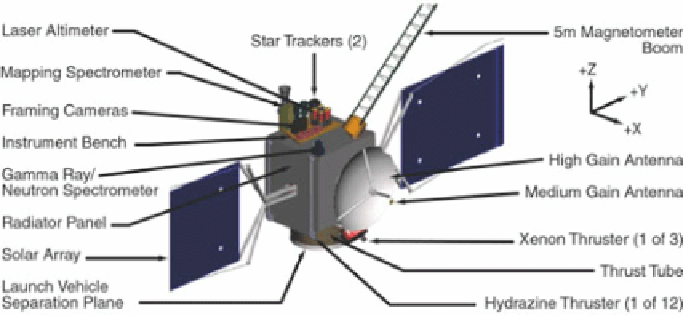Geoscience Reference
In-Depth Information
Fig. 1.
A schematic illustration of the general design of the spacecraft.
in October, 2011. The departure from Vesta should be in May, 2012, and
the arrival to Ceres is planned in August, 2015. The mission end will be in
January, 2016. According to this schedule, Dawn will spend several months
orbiting around Vesta and Ceres, and will have time to produce extensive
investigations of these two asteroids.
A preliminary design of the Dawn spacecraft is shown in Fig. 1. The
on-board scientific instruments will be two redundant framing cameras
(FCs), produced by DLR/MPAe, a visible and infrared mapping spectrom-
eter (VIR), produced by ASI, and a Gamma ray and neutron detector
(GRaND), produced by the Los Alamos National Laboratory. In addition,
the JPL will take charge of the gravity science data, from which the masses
of the two target asteroids will be accurately determined.
The on-board instruments will permit to derive an impressive amount of
data, including (1) a full surface imagery of Vesta and Ceres in at least three
colors; (2) full spectrometric maps of the surfaces in three bands, namely
0.35-0.9, 0.8-2.5, and 2.4-5.0
µ
m; (3) abundances estimations for the Fe,
Ti,O,Si,Ca,U,Th,K,H,Al,andMgelements;(4)determinationofthe
spherical harmonics development of the gravity field up to ninth degree for
Vesta and fifth degree for Ceres.
Accordingly, we can expect that Dawn will be able to produce an impres-
sive list of scientific results, including:
•
A very accurate determination of the shape, size, composition and mass
of both Ceres and Vesta.
•
The determination of the internal structure, density and homogeneity of
these two asteroids.










